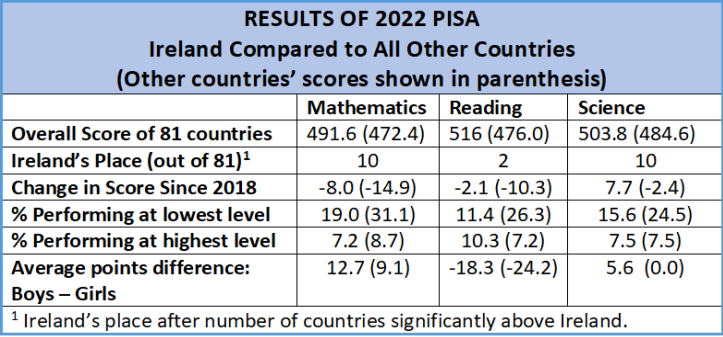School Report: High Marks for Ireland (But Could do Better!).
Surprisingly little has been made either by the government or the media about the results of the 2002 PISA report by the OECD released on 5 December. The results for Ireland are extremely good.
PISA (Programme for International Student Assessment) is a global survey taken every three years by the OECD. Students at age 15/16 are tested in three areas: Maths, Reading and Science.
A sample of 690,000 students were tested throughout 81 countries of which 5,569 in 170 schools in Ireland. The test is computer and paper based and teachers and parents also have to fill in questionnaires.
The attached table shows Ireland’s rank in the three subject areas. Ireland was
tenth in Mathematics,
second in Reading and
tenth in Science.
That is to say, we were better than, for example, Germany at Mathematics, England at Reading or the US at Science.
The dominance of far eastern countries should be noted. Singapore was in first place in all three subjects and six other countries in the far east including Hong Kong, Japan, Taiwan and Korea were always in the top ten places. In addition to Ireland , Canada and Estonia were the only non-oriental countries to make it to the top ten places in all three subjects.
Worryingly, the overall scores were lower in 2022 than those recorded in the previous PISA which was 2018. As can be seen, Ireland also lost ground in two of the subjects (Maths and Reading) but less so than the average and pulled ahead against the trend in Science. The impact of Covid may have had something to do with the declines.

The PISA also asks questions about equality measured by the share of students in each country who scored in the lowest quintile. Again, Ireland betters the average with 19% of our students in the bottom quintile in Maths against 31.1% of the total 81 countries and similarly in the other two subjects.
At the upper end of the scale Ireland has a smaller share in the top quintile in Maths than the rest of the sample. On the other hand we are ahead in Reading (i.e. where we combine a relatively small share in the bottom and a large share in the top) and we are level pegging in Science.
The last measure of quality is with respect to gender. In Ireland boys do better than girls at Maths, girls do better than boys at Reading and the difference in Science is not significant. The difference is less than the averages for all countries.
The report also takes account of the impact of social and cultural factors (e.g. accounting for the impact of class and culture on results) and immigration (where Ireland’s level of immigration is 17.4% compared with 12.9% for all countries). But analysis of this is complex and difficult to summarise.
In short: this is a major success and a credit to pupils, parents, teachers and the Department. It shows very good results and with a high degree of equality in our schools. The report deserves wider circulation. In short: this is a major success and a credit to pupils, parents, teachers and the Department. It shows very good results and with a high degree of equality in our schools. The report deserves wider circulation.